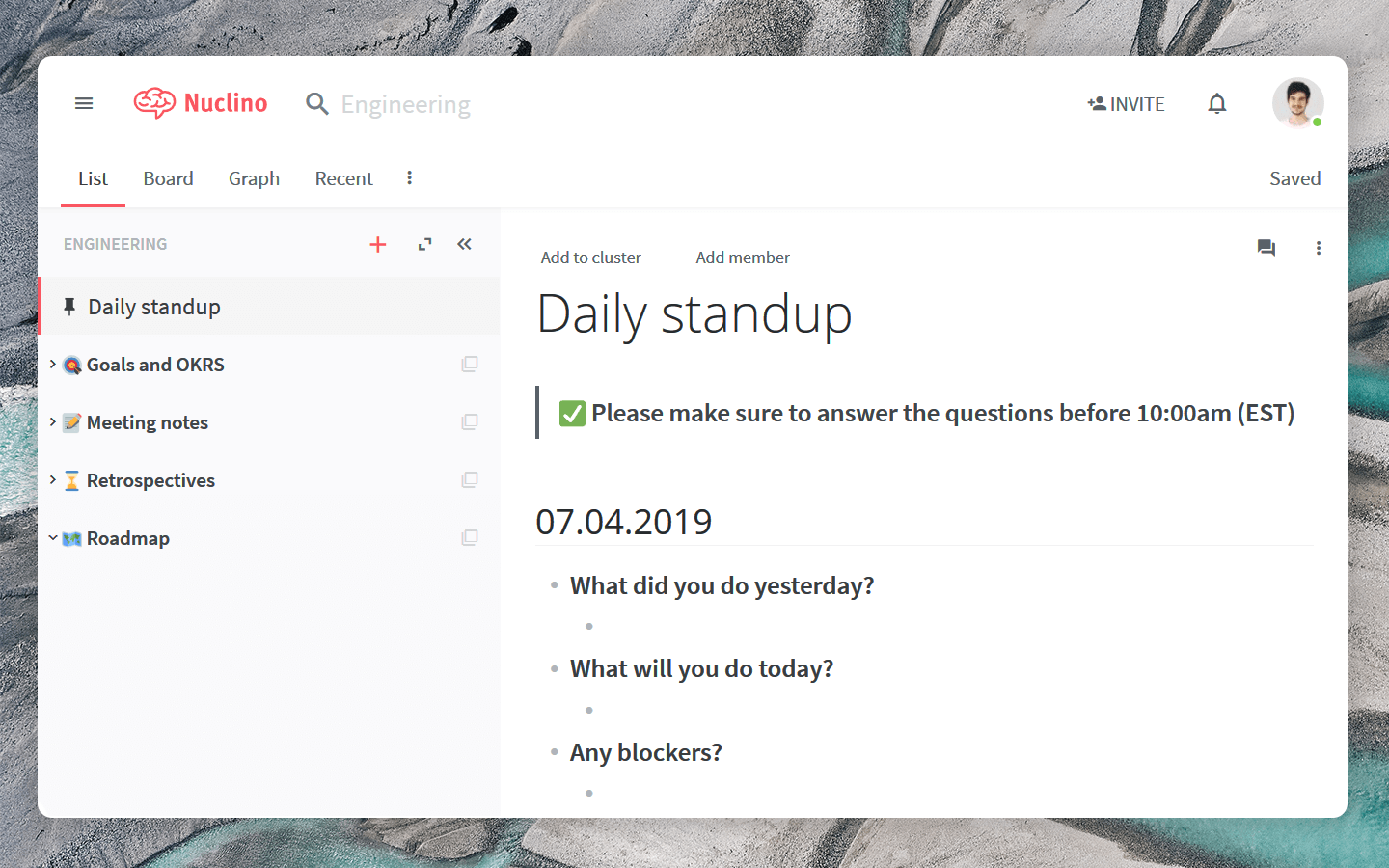Why the daily standup meeting is an anti-pattern (and how to fix it)

Those of us who work with Agile and Scrum methodologies have had our fair share of daily standup meetings, and they could likely be one of the best (or worst) meetings you’ll have at work.
At its best, a standup meeting ensures that continual progress is made while keeping each person accountable for their work.
At its worst, it's a disruptive meeting where people talk about the work that they aren’t actually doing for way longer than planned while getting painful leg cramps.
Here's why our team at Nuclino has banned daily standups.
How daily standup meetings are supposed to work
In an ideal world, a daily standup lasts a maximum of 15 minutes, with a team size of no more than eight people, and consists of the following questions:
What did you do yesterday?
What will you do today?
Any blockers?
Simple enough – yet, rarely the case.
How standup meetings actually work
Standups go overtime – a lot
Overly large team sizes, long-winded answers, and out-of-place one-on-one conversations often make daily standups drag way past the planned 15 minutes. That's often the case even for the most disciplined teams, making standup meetings easily the most expensive of the scrum ceremonies, as they happen every single day.

If you have to resort to planking to keep the meeting time-boxed, it's a big fat red flag indicating that something isn't working right.
They are disruptive and hard to coordinate
15 minutes may not seem like a lot, but even if the meeting doesn't go overtime, it ends up costing a lot more than that. Nothing substantial will be done in the 15-30 minutes leading up to the meeting – why start working on something important or complicated if you're going to be interrupted anyway? Regaining your focus after the standup would take time as well.
To avoid unnecessary work disruption you can try doing the standup meetings early in the morning, but if your office hours are at least somewhat flexible, "early in the morning" would mean a different thing to everyone. Some people get to the office at 8am, others at 9am, and others at 10am – you end up with half the team already working at full speed while others are just arriving.
And if some team members are working from home or in a different timezone, it’s another big layer of issues to deal with. Joining a daily standup meeting at 9pm is not fun for anyone and will reflect badly on the overall team productivity as well.
There’s no record of the discussion
Whatever happened during the standup, you'll likely only know if you attended it. In most cases, there’s no history of the discussion for new or existing team members to reference at a later time. In case some team members were late or busy with a customer, you end up with another time-waster in the form of a daily "Did I miss anything important?" bounced around the office.
Bottom line, conducting consistently smooth synchronous standups can be challenging.
Synchronous vs. asynchronous standups
In recent time, many Agile teams looking to maximize their productivity have switched to asynchronous standups. Unlike traditional daily standup meetings, these standups take place over time in a non-blocking manner. At a specific time of the day, team members are notified and prompted to answer the same three standup questions – in writing.
How to best implement them is up to the team. Some have adopted Slack bots, others use Google Docs. Our team uses our own internal wiki tool Nuclino:

Inline comments and @-mentions allow us to easily give feedback and follow up on each point individually without making the whole team wait.

Pros
Asynchronous daily standups allow for a non-intrusive process that helps many teams – including our own – stay focused on important tasks. The perks include:
Knowledge sharing. Whatever tool you choose, it will maintain a log of all of your previous standups. A daily standup that is documented is something that can be easily viewed and referenced by others, creating a culture of transparency, facilitating knowledge sharing, and helping onboard new team members. The quality of the information will be higher as well: After all, when people have time to think and compose a written message, it will likely be better than whatever they might say when put on the spot in front of a bunch of people.
Convenient for remote team members. No more 9pm Skype calls – with asynchronous communication team members working from home or located across multiple time zones can provide answers to the three standup meeting questions at the start of their day.
Focus and time-saving. The larger your team, the more likely they are to drift off and start day-dreaming. Asynchronous standups may not guarantee full focus at all times, but at least you don’t miss anything – you can go back and reread at any time. Not having to wait for other team members to finish their spontaneous one-on-one and following up on relevant issues individually is also much more efficient from a time savings perspective.
Cons
However, asynchronous standups are not without drawbacks and may not be for every team. Here are a few reasons to be cautious:
Blockers may not be immediately addressed. The main benefit of synchronous standup meetings is that standing face-to-face puts more pressure on the team to address blockers right away. With asynchronous standups, team members may need to be more diligent about bringing awareness to their blockers.
Not great for reinforcing team culture. One of the more subtle advantages of synchronous standup meetings is that it brings the team together and adds a human element to the interaction. In a remote team, a daily standup may be your only contact with other coworkers all day.
Asynchronous standups take discipline. Going asynchronous adds flexibility to your team's schedule which can be both good and bad for the overall productivity. Removing the sense of urgency that comes with having to deliver your answers in front of the whole team may lead to members forgetting to write their answers or writing them after the deadline. This issue can be addressed with a calendar reminder and, if needed, a penalty system.
.gif)
It’s worth asking if daily standups are productive, especially if video calls are necessary. But one of the great things about Agile is that it's designed to handle change and encourages teams to experiment with different ways to improve the process. If you struggle with your daily standup meetings, it's definitely worth giving asynchronous standups a try for a sprint or two.